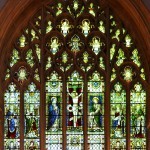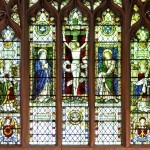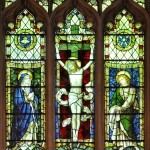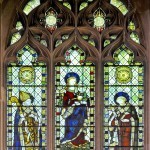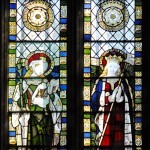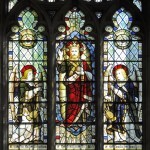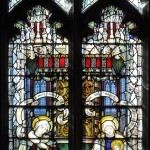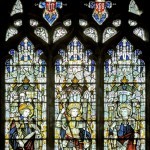The windows at St Aldhelms are not only aesthetically beautiful but they also have an interesting history which we are trying to piece together here. We are fortunate to have windows from two of the leading companies of the period (Burlison & Grylls) and (Kempe)
We are very grateful to Mr Peter Moore for the information provided and for the main pictures below which have managed to capture their beauty.
Peter is the great-grandson of Mr Thomas John Grylls, the founder of the firm Burlison & Grylls and he is attempting to catalouge all their work, made very difficult due to their London studio being bombed during WW2 during which all records were lost.
Without records Peter has to resort to a number of sources ie faculties, newspapers and old parish magazines but mostly by recognising the quality of the drawing, the style of lettering and even facial characteristics as they often used their large family as models!!
For more information on windows from Burlison & Grylls please visit www.flickr.com/photos/99168983@N00/ and www.flickr.com/groups/1108003@N21/
For information on Kempe please visit http://en.wikipedia.org/wiki/Charles_Eamer_Kempe
Windows from Burlison & Grylls – see information below
7 lights.
Elaborate tracery of angels with scrolls, white roses etc.
Left outer, under roundel of evangelist symbol and scroll, and above panel of instruments of Passion set in shields held by angels, and against backcloths: St Peter, with book and keys; St Aldhelm, with model of church (as originally designed with campanile):
3 centre lights, against backcloths: simple Crucifixion tableau, Virgin under roundel of purse of coins marked ’30’, St John under roundel of Christ’s pierced hands, feet and heart, subscription ‘I, if I be lifted up from the earth, will draw all men unto me’, above panels of patterned quarries set with scroll, ‘he was wounded for our transgressions’, roundel with pelican feeding her young, and scroll, ‘he was bruised for our iniquities’. Right outer, under roundel of evangelist symbol and scroll, and above panel of instruments of Passion set in shields held by angels, and against backcloths: St Augustine, holding crucifixion icon; St Paul, holding sword of martyrdom.
Plaque in chancel: IM Emily Sophia Doyne +31.12.1907 and her son Charles Goddard Doyne +19.03.1909, 27 years Vicar, by relatives and friends who ‘have carried out his wish to place this East Window as a memorial of her life and work in the parish.’
Burlison & Grylls, 1911
East window detail of main lights.
7 lights. Left outer, under roundel of evangelist symbol and scroll, and above panel of instruments of Passion set in shields held by angels, and against backcloths: St Peter, with book and keys; St Aldhelm, with model of church (as originally designed with campanile): 3 centre lights, against backcloths: simple Crucifixion tableau, Virgin under roundel of purse of coins marked ’30’, St John under roundel of pierced hands, feet and heart, subscription ‘I, if I be lifted up from the earth, will draw all men unto me’, above panels of patterned quarries set with scroll, ‘he was wounded for our transgressions’, roundel with pelican feeding her young, and scroll, ‘he was bruised for our iniquities’. Right outer, under roundel of evangelist symbol and scroll, and above panel of instruments of Passion set in shields held by angels, and against backcloths: St Augustine, holding crucifixion icon; St Paul, holding sword of martyrdom.
Burlison & Grylls, 1911.
3 lights. Under mixed tracery, quatrefoils and sacred monograms. Against patterned quarries,
left: under roundel of white rose, figure of bishop with crozier, subscription ‘God is the King of all the earth: God reigneth over the heathen’;
centre: Virgin holding sheaf of lilies and child holding orb, subscription ‘My soul doth magnify the Lord, & my spirit doth rejoice in God my Saviour’;
right: under roundel of white rose, St Francis, holding crucifix, subscription ‘I will love thee, O Lord my strength; the Lord is my stony rock & my defence.’
Brass plaque beneath: IM Francis Colville Hyde, b. Kent 24.07.1826, d. ‘in this parish’ 9.03.1892.
CH suggests bishop in left light may be Bp. Wordsworth of Salisbury (1843- Bp. 1885 -1911), who dedicated first part of the church in 1894 (tomb in Salisbury Cathedral). Colville Hyde JP, described as landowner and magistrate, had been High Sheriff of Kent, 1853: 1891 census shows his wife as Charlotte, with 2 sons and 5 daughters (see DOR_07_04) and a household comprising a governess and seven domestics.
Burlison & Grylls, 1890s.
2 lights. Simple tracery: sacred monogram in quatrefoil. Surmounted by white rose roundel set in patterned quarries, and against backcloths; St Agnes, reading, subscription ‘Goodness and mercy…’ Psalm 23:6, lamb at her feet. St Margaret of Antioch, crowned, with staff piercing dragon at her feet, subscription ‘O let me not be confounded…’ Psalm 69:6. Panels below: sacred monograms, in shields with star, against foliage pattern quarries.
Brass plaque beneath: IM Constance Elena Hyde 6.11.1864-17.02.1893 (3rd daughter of Francis Colville Hyde, see DOR_07_02).
Burlison & Grylls, 1890s
3 lights. Under simple tracery, 2 sexfoils with sacred monograms within shields. Against patterned quarries, Christ majestic in centre, crowned and holding orb, in mandorla, flanked each side by a censing angel surmounted by white rose. Subscription ‘I look for the resurrection of the dead…’ (Nicene Creed). Panels below: instruments of Passion, in shields with star, against foliage pattern quarries.
Burlison & Grylls,
Burlison & Grylls, 1868-1953
John Burlison 1843-1891 and Thomas John Grylls 1845-1913 met as apprentices in the firm of Clayton & Bell, one of the largest and most ‘commercial’ of the Victorian stained glass window originators. Burlison’s father was personal assistant to the architect Sir George Gilbert Scott, and his sister married Alfred Bell. Thomas Grylls’ father was a manager for the organ builders Walker. In other words, both had promising connections, and these they exploited when, in 1868, with the encouragement of the architect G F Bodley, they set up their own stained glass firm off Oxford Street, London.
The consolidation of their partnership by John Burlison’s marriage to Elizabeth Sarah Grylls in 1870, and the large families with which both were blessed are sufficient testimony to the success of the firm over the following decades. Most of their work appears to have come from the architects who were busy restoring the medieval parish churches scattered throughout England, G F Bodley, G E Street, Gilbert Scott father and son. As business expanded, they were able to undertake a variety of tasks involving restoration and decoration, mainly of chancel and sanctuary areas and often working to an architect’s specifications, as well as gaining a reputation for good quality restoration of old glass and a delicate and restrained style in their own glass.
From the early days John Burlison appears to have run the administrative side of the business: Thomas John Grylls was responsible for most of the designing, and appears to have gathered about him a small caucus of craftsmen, each with their own particular speciality, and eventually supplemented by his own talented children.
After Burlison’s death in 1891, Grylls’ eldest son Thomas Henry (Harry) took over the administration: himself talented as an heraldic artist, he was thus able to continue the firm after his father’s death in 1913, though initially his designs leant heavily upon his father’s tradition, and he responded particularly to the demand for war memorials.
Latterly business declined, and the WW2 bombing of their Great Ormond Street premises effectively brought closure. To date, the work of Burlison & Grylls is largely undocumented: records appear to have been lost, and the windows were unsigned: thus an accurate and complete compilation is virtually impossible.
The remaining windows are from the firm Kempe

